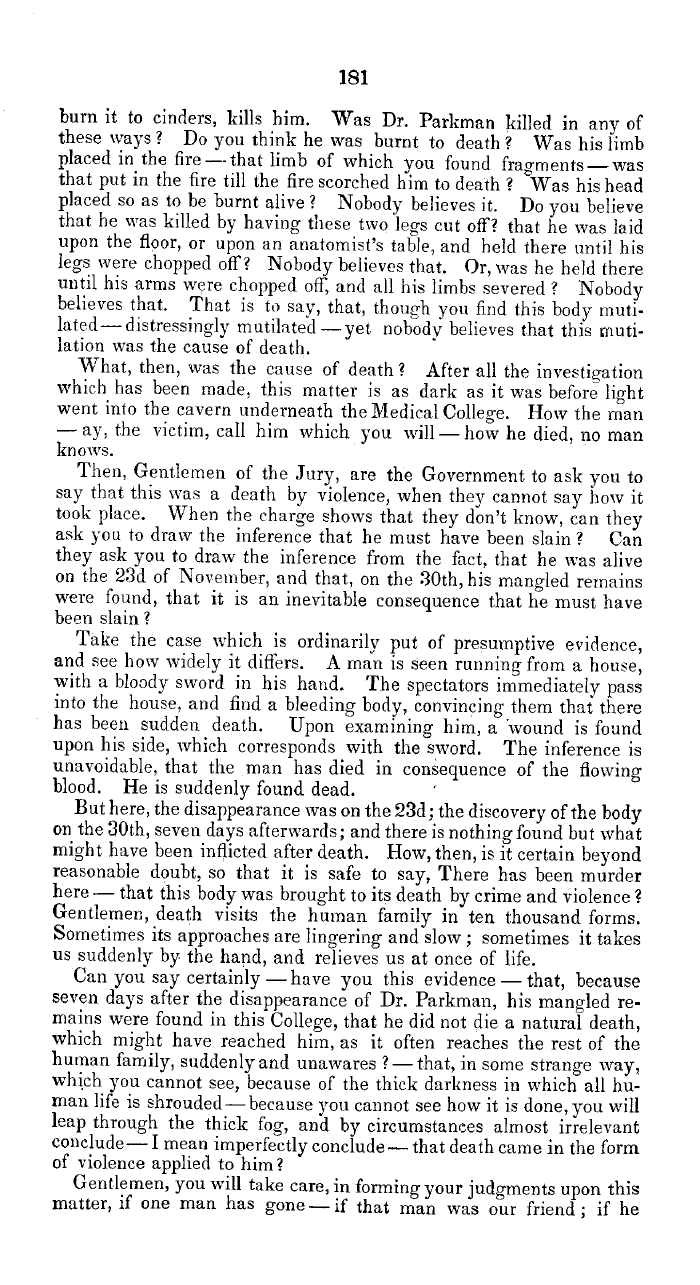|
181
burn it to cinders, kills him. Was Dr. Parkman killed in any of
these ways ? Do you think he was burnt to death ? Was his limb
placed in the fire--that limb of which you found fragments-was
that put in the fire till the fire scorched him to death ? Was his head
placed so as to be burnt alive ? Nobody believes it. Do you believe
that he was killed by having these two legs cut off? that he was laid
upon the floor, or upon an anatomist's table, and held there until his
legs were chopped off? Nobody believes that. Or, was he held there
until his arms were chopped off; and all his limbs severed ? Nobody
believes that. That is to sav, that, though you find this body muti-
lated-distressingly mutilated-yet nobody believes that this muti-
lation was the cause of death.
What, then, was the cause of death? After all the investigation
which has been made, this matter is as dark as it was before light
went into the cavern underneath the Medical College. How the man
-ay, the victim, call him which you will-how he died, no man
knows.
Then, Gentlemen of the Jury, are the Government to ask you to
say that this was a death by violence, when they cannot say how it
took place. When the charge shows that they don't know, can they
ask you to draw the inference that he must have been slain ? Can
they ask you to draw the inference from the fact, that he was alive
on the 23d of November, and that on the 30th, his mangled remains
were found, that it is an inevitable consequence that he must have
been slain?
Take the case which is ordinarily put of presumptive evidence,
and see how widely it differs. A man is seen running from a house,
with a bloody sword in his hard. The spectators immediately pass
into the house, and find a bleeding body, convincing them that there
has been sudden death. Upon examining him, a 'wound is found
upon his side, which corresponds with the sword. The inference is
unavoidable, that the man has died in consequence of the flowing
blood. He is suddenly found dead.
But here, the disappearance was on the 23d; the discovery of the body
on the 30th, seven days afterwards; and there is nothing found but what
might have been inflicted after death. How, then, is it certain beyond
reasonable doubt, so that it is safe to say, There has been murder
here - that this body was brought to its death by crime and violence ?
Gentlemen, death visits the human family in ten thousand forms.
Sometimes its approaches are lingering and slow; sometimes it takes
us suddenly by the hand, and relieves us at once of life.
Can you say certainly -have you this evidence -that, because
seven days after the disappearance of Dr. Parkman, his mangled re-
mains were found in this College, that he did not die a natural death,
which might have reached him, as it often reaches the rest of the
human family, suddenly and unawares ?-that, in some strange way,,
which you cannot see, because of the thick darkness in which all hu-
man life is shrouded-because you cannot see how it is done, you will
leap through the thick fog, and by circumstances almost irrelevant
conclude-I mean imperfectly conclude-that death came in the form
of violence applied to him?
Gentlemen, you will take care, in forming your judgments upon this
matter, if one man has gone - if that man was our friend ; if he
|

